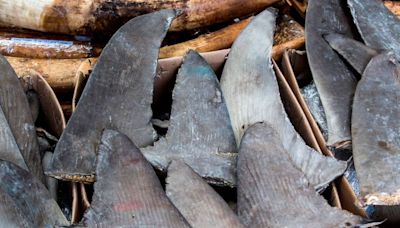Search results
Sharks are a group of elasmobranch fish characterized by a cartilaginous skeleton, five to seven gill slits on the sides of the head, and pectoral fins that are not fused to the head. Modern sharks are classified within the clade Selachimorpha (or Selachii) and are the sister group to the Batoidea ( rays and kin).
Find out about the world's biggest and fastest sharks, how sharks reproduce, and how some species are at risk of extinction. Subscribe: http://bit.ly/NatGeoSubscribe #NationalGeographic #Sharks #...
2 days ago · Shark, any of numerous species of cartilaginous fishes that make up the order Selachii (class Chondrichthyes). Most species have a tough skin that is dull gray in color and roughened by toothlike scales. The mouth contains sharp triangular teeth. Sharks lack a swim bladder and must swim to keep from sinking.
Find out about the world's biggest and fastest sharks, how sharks reproduce, and how some species are at risk of extinction. Common Name: Sharks. Type: Fish. Size: 7 inches to 32.8 feet. Weight...
The oceanic whitetip, porbeagle and three hammerhead species are some of the shark species of concern for WWF, where the impact of trade is contributing to declines in populations. Millions of these sharks continue to be fished annually to supply the persistent demand for their fins and meat.
Most sharks are predators: they hunt and eat fish, marine mammals, and other sea creatures. However, the largest shark eats krill, like whales. This is the whale shark, the largest fish in the world. It is widely believed that sharks are "silent killers".
Jun 13, 2005 · Read on for more surprising shark facts compiled by National Geographic News: • Each year there are about 50 to 70 confirmed shark attacks and 5 to 15 shark-attack fatalities around the...
Facts about many sharks from the eight orders of sharks from the Shark Research Institute (SRI). SRI conducts and sponsors rigorous, peer-reviewed field research about sharks and uses science-based information to educate and advocate for shark conservation policies and protections by the world’s governing bodies, including CITES.
Introduction. There are more than 500 species of sharks swimming in the world’s ocean. Yet when most people think of these cartilaginous fish, a single image comes to mind: a large, sharp-toothed and scary beast. That generalization does sharks a huge disservice, as they have far more variety than that.
Sharks live all over the world, from warm, tropical lagoons to polar seas. Some even inhabit freshwater lakes and rivers! Sharks are fishes. Like other fishes, sharks are cold-blooded, have fins, live in the water, and breathe with gills. A shark's skeleton is made of cartilage.






